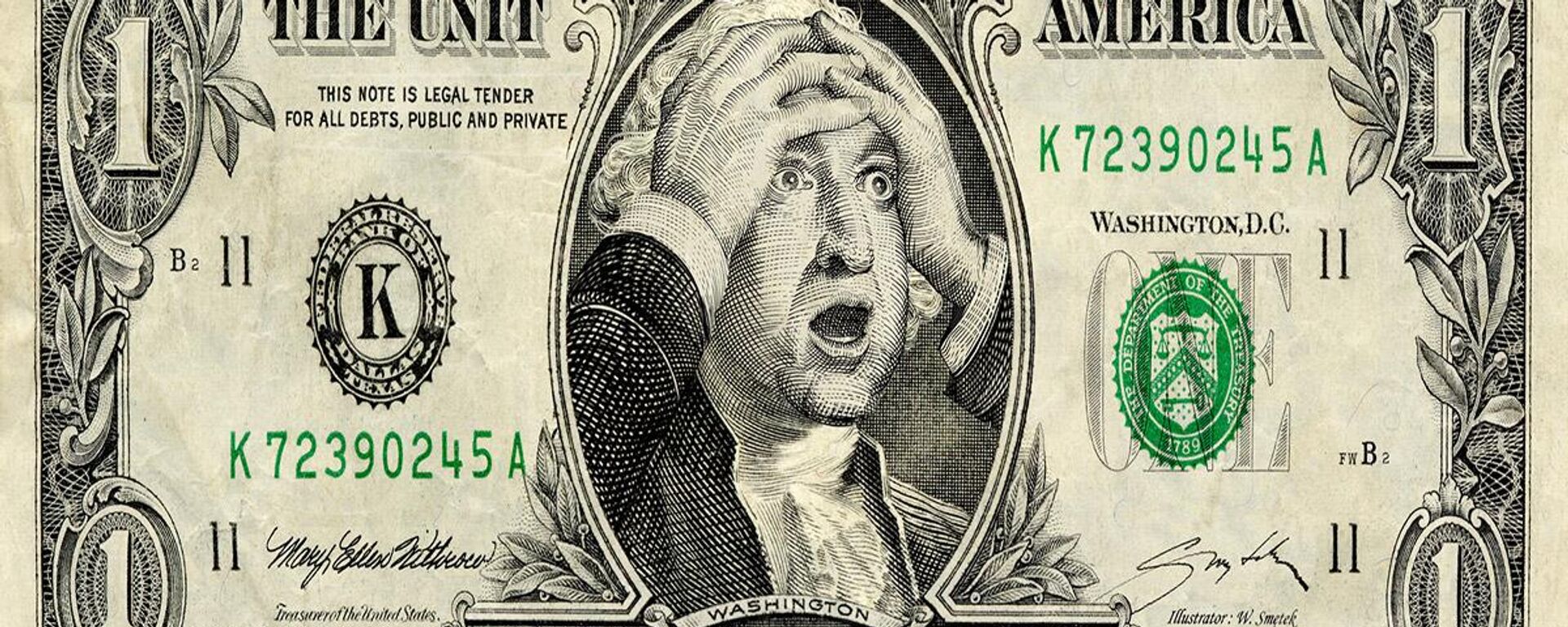https://sputniknews.in/20230926/what-is-de-dollarization-4438234.html
What is De-Dollarization?
What is De-Dollarization?
Sputnik India
The term de-dollarization has gained widespread attention in recent months, especially after the imposition of unilateral Western sanctions on Russia.
2023-09-26T17:12+0530
2023-09-26T17:12+0530
2023-10-04T17:42+0530
dedollarisation
vladimir putin
us
india
russia
brics
trade in national currencies
uae
malaysia
bangladesh
https://cdn1.img.sputniknews.in/img/07e7/05/0f/1974754_0:160:3073:1888_1920x0_80_0_0_f2f9ef1aa42986a7074dd1778095ba8f.jpg
De-dollarisation has found all sorts of fans among the leaders of the Global South, as well as President Vladimir Putin who has been one of the most active supporters for switching to trade in national currencies. Nations which at present are leading this initiative include India, Bangladesh, Iran, China, the Association of South-East Asian Nations (ASEAN) bloc, Middle East countries and the members of BRICS.Given this widespread enthusiasm, Sputnik India investigated what exactly de-dollarisation is.What is De-Dollarisation all about?For the uninitiated, de-dollarisation is a step towards accomplishing a global economic order where the US dollar will no longer be the world's most dominant reserve currency.After America emerged as the world's major economy after the Second World War, the greenback became one of the most important symbols of the country's predominance.What is the strongest currency in the world?The dollar has maintained its position at the top of the currency tree because of its overall contribution to international forex reserves.For instance, the US dollar had an 85 percent share in the global foreign currency in the Seventies which fell to around 70 percent at the start of the 21st century.According to an International Monetary Fund (IMF) report published recently, it then declined further to its present level of 58.35 percent - its lowest level ever.Among other currencies, the Euro, which is used in 20 European countries, is the second-most used currency in the world, having a 20 percent share in the world's forex reserves followed by Japan's Yen at 5 percent.The Chinese renminbi's share in foreign currency reserves stands at just under 2.7 percent although its representation in this has almost doubled in the past seven years.Why Countries Want De-DollarisationIn this light, the trend toward de-dollarisation is largely driven by countries that are either dealing with the negative effects of economic sanctions imposed on them by the West - such as Russia and Iran - or by nations such as China which is emerging as a direct rival to America's dominance in global geopolitics, or India, an emerging superpower in the world.Despite the threat of US sanctions, India has become one of Russia's largest trading partners alongside China with trade between the two nations touching nearly $45Bln in the last fiscal year and expected to reach $100Bln to $125Bln in the next three years.Most of the India-Russia trade has taken place in national currencies after the Eurasian and its South Asian partner decided to kickstart a Rupee-Rouble payment system.As well as Russia, India has signed similar agreements with the governments of Bangladesh, the UAE, Malaysia, Nepal, Bhutan, and Iran.Furthermore, in what was being described as ASEAN's push towards de-dollarisation, five of the bloc's 10 members - Indonesia, Malaysia, Singapore, Thailand, and the Philippines - signed a Memorandum of Understanding (MoU) to promote local currency usage for trade purposes earlier this year.What is the Dollarisation of the Rupee? The dollarisation of the rupee meant that India used the US dollar to import goods from foreign countries instead of making payments in its own currency.This was largely to avoid volatility in financial markets, particularly the problems related to unstable exchange rates.However, unlike in the past, the INR has become one of the least volatile major currencies in the world. Thus, the country's central bank, the Reserve Bank of India, has made efforts toward the internationalisation of the rupee.Is Dollarisation Good for India?For nations such as India that have limited US dollar reserves, using the dollar for international payments makes them vulnerable to American monetary decisions.But if they move away from the greenback by diversifying their reserves, it offers them enhanced financial stability and heightened monetary autonomy.Will BRICS Launch a Currency to End Dollar's Dominance?Speculation over a common BRICS currency has been rife despite the fact that the powerful economic grouping - which now has 11 states since six new members were inducted last month - dismissing media reports about such a move.However, an American financial expert thought that BRICS could still opt for the creation of a "viable alternative to the US dollar"."BRICS could create a viable alternative to the US dollar. Therefore, the US dollar would indeed be overthrown as the predominant global currency", American economist Jeffrey Sachs told Sputnik."BRICS will accelerate the transition to a multi-currency system. The dollar will still play its role, but much less among the many currencies," Sachs concluded.
https://sputniknews.in/20230901/brics-to-create-alternative-to-us-dollar-to-end-greenback-dominance-american-economist-3971288.html
us
india
russia
uae
malaysia
bangladesh
nepal
bhutan
china
japan
iran
moscow
delhi
new delhi
Sputnik India
feedback.hindi@sputniknews.com
+74956456601
MIA „Rossiya Segodnya“
2023
Pawan Atri
https://cdn1.img.sputniknews.in/img/07e6/0c/13/139630_147:0:831:684_100x100_80_0_0_8fa2b25903e7787fe6a2698552c167df.png
Pawan Atri
https://cdn1.img.sputniknews.in/img/07e6/0c/13/139630_147:0:831:684_100x100_80_0_0_8fa2b25903e7787fe6a2698552c167df.png
News
en_IN
Sputnik India
feedback.hindi@sputniknews.com
+74956456601
MIA „Rossiya Segodnya“
Sputnik India
feedback.hindi@sputniknews.com
+74956456601
MIA „Rossiya Segodnya“
Pawan Atri
https://cdn1.img.sputniknews.in/img/07e6/0c/13/139630_147:0:831:684_100x100_80_0_0_8fa2b25903e7787fe6a2698552c167df.png
what is de-dollarization, de dollarization, de-dollarization, dedollarization, dedollarisation, what is dedollarization, dedollarization meaningbrics dedollarization, dedollarisation upsc, dedollarisation meaning, dedollarisation india, dedollarisation news, what is dedollarisation, brics dedollarisation, dedollarisation impact, dedollarisation 2023, de dollarization countries, de dollarization indian rupees, is de dollarization possible, effects of de-dollarization, de dollarization meaning in hindi, when will indian rupee value increase against dollar, de-dollarisation russia, trade in national currencies, move away from us dollar as reserve currency, percentage of us dollar in world's reserve currency, why russia wants dedollarization, why russia wants dedollarisation, brics currency, dedollarization news, dedollarization, us dollar hegemony, brics summit, johannesburg 2 declaration, brics news, columbia university, jeffrey sachs, russia ukraine news, g7 sanctions, g7 sanctions against russia, russia ukraine war, western sanctions against russia, trade in national currencies, dedollarization of global economy, what is dedollarization, dedollarization news, dedollarization india, is dollarisation good for india, will brics launch a currency to end dollar's dominance, what is the dollarisation of the rupee, why countries want de-dollarisation, what is the strongest currency in the world, what is de-dollarisation all about
what is de-dollarization, de dollarization, de-dollarization, dedollarization, dedollarisation, what is dedollarization, dedollarization meaningbrics dedollarization, dedollarisation upsc, dedollarisation meaning, dedollarisation india, dedollarisation news, what is dedollarisation, brics dedollarisation, dedollarisation impact, dedollarisation 2023, de dollarization countries, de dollarization indian rupees, is de dollarization possible, effects of de-dollarization, de dollarization meaning in hindi, when will indian rupee value increase against dollar, de-dollarisation russia, trade in national currencies, move away from us dollar as reserve currency, percentage of us dollar in world's reserve currency, why russia wants dedollarization, why russia wants dedollarisation, brics currency, dedollarization news, dedollarization, us dollar hegemony, brics summit, johannesburg 2 declaration, brics news, columbia university, jeffrey sachs, russia ukraine news, g7 sanctions, g7 sanctions against russia, russia ukraine war, western sanctions against russia, trade in national currencies, dedollarization of global economy, what is dedollarization, dedollarization news, dedollarization india, is dollarisation good for india, will brics launch a currency to end dollar's dominance, what is the dollarisation of the rupee, why countries want de-dollarisation, what is the strongest currency in the world, what is de-dollarisation all about
De-dollarisation has found all sorts of fans among the leaders of the Global South, as well as President Vladimir Putin who has been one of the most active supporters for switching to trade in national currencies.
Nations which at present are leading this initiative include
India, Bangladesh, Iran, China, the Association of South-East Asian Nations (ASEAN) bloc, Middle East countries and the members of BRICS.
Given this widespread enthusiasm, Sputnik India investigated what exactly de-dollarisation is.
What is De-Dollarisation all about?
For the uninitiated, de-dollarisation is a step towards accomplishing a global economic order where the US dollar will no longer be the world's most dominant reserve currency.
After America emerged as the world's major economy after the Second World War, the greenback became one of the most important symbols of the country's predominance.
What is the strongest currency in the world?
The dollar has maintained its position at the top of the currency tree because of its overall contribution to international forex reserves.
For instance, the US dollar had an 85 percent share in the global foreign currency in the Seventies which fell to around 70 percent at the start of the 21st century.
According to an International Monetary Fund (IMF) report published recently, it then declined further to its present level of 58.35 percent - its lowest level ever.
Among other currencies, the Euro, which is used in 20 European countries, is the second-most used currency in the world, having a 20 percent share
in the world's forex reserves followed by Japan's Yen at 5 percent.
The Chinese renminbi's share in foreign currency reserves stands at just under 2.7 percent although its representation in this has almost doubled in the past seven years.
Why Countries Want De-Dollarisation
In this light, the trend toward de-dollarisation is largely driven by countries that are either dealing with the negative effects of economic sanctions imposed on them by the West - such as Russia and Iran - or by nations such as China which is emerging as a direct rival to America's dominance in global geopolitics, or India, an emerging superpower in the world.
Despite the threat of US sanctions, India has become one of Russia's largest trading partners alongside China with trade between the two nations touching nearly $45Bln in the last fiscal year and expected to reach $100Bln to $125Bln
in the next three years.
Most of the India-Russia trade has taken place in national currencies after the Eurasian and its South Asian partner decided to kickstart a Rupee-Rouble payment system.
As well as Russia, India has signed similar agreements with the governments of Bangladesh, the UAE, Malaysia, Nepal, Bhutan, and Iran.
Furthermore, in what was being described as ASEAN's push towards de-dollarisation, five of the bloc's 10 members - Indonesia, Malaysia, Singapore, Thailand, and the Philippines - signed a Memorandum of Understanding (MoU) to promote local currency usage for trade purposes earlier this year.
What is the Dollarisation of the Rupee?
The dollarisation of the rupee meant that India used the US dollar to import goods from foreign countries instead of making payments in its own currency.
This was largely to avoid volatility in financial markets, particularly the problems related to unstable exchange rates.
However, unlike in the past, the INR has become one of the least volatile major currencies in the world. Thus, the country's central bank, the Reserve Bank of India, has made efforts toward the internationalisation of the rupee.
Is Dollarisation Good for India?
For nations such as India that have limited US dollar reserves, using the dollar for international payments makes them vulnerable to American monetary decisions.
But if they move away from the greenback by diversifying their reserves, it offers them enhanced financial stability and heightened monetary autonomy.
Will BRICS Launch a Currency to End Dollar's Dominance?
Speculation over a common BRICS currency has been rife despite the fact that the powerful economic grouping - which now has 11 states since six new members were inducted last month - dismissing media reports about such a move.
However, an American financial expert thought that BRICS could still opt for the creation of a "viable alternative to the US dollar".
"BRICS could create a viable alternative to the US dollar. Therefore, the US dollar would indeed be overthrown as the
predominant global currency", American economist Jeffrey Sachs told Sputnik.
"BRICS will accelerate the transition to a multi-currency system. The dollar will still play its role, but much less among the many currencies," Sachs concluded.



